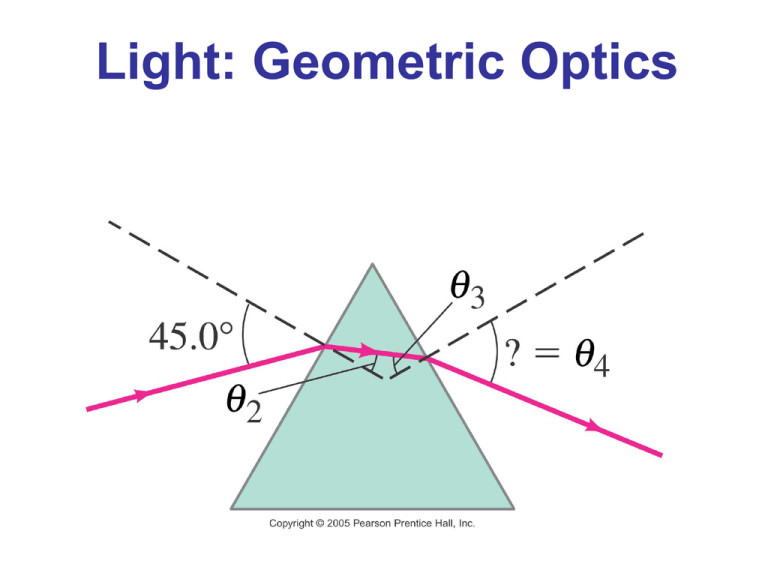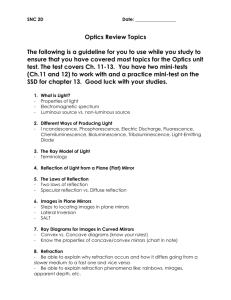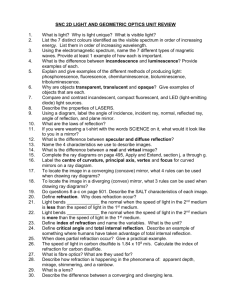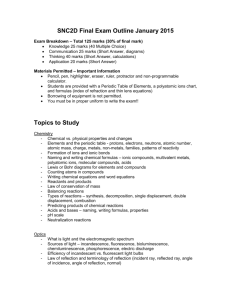
Light: Geometric Optics
Units of Chapter 23
• The Ray Model of Light
• Reflection; Image Formed by a Plane Mirror
• Formation of Images by Spherical Mirrors
• Index of Refraction
• Refraction: Snell’s Law
Units of Chapter 23
• Total Internal Reflection; Fiber Optics
• Thin Lenses; Ray Tracing
• The Thin Lens Equation; Magnification
• Combinations of Lenses
• Lensmaker’s Equation
23.2 Reflection; Image Formation by a
Plane Mirror
Law of reflection: the angle of reflection
(that the ray makes with the normal to a
surface) equals the angle of incidence.
23.2 Reflection; Image Formation by a
Plane Mirror
When light reflects from a rough surface, the law
of reflection still holds, but the angle of
incidence varies. This is called diffuse reflection.
23.2 Reflection; Image Formation by a
Plane Mirror
With diffuse reflection, your eye sees
reflected light at all angles. With specular
reflection (from a mirror), your eye must be in
the correct position.
23.2 Reflection; Image Formation by a
Plane Mirror
What you see when you look into a plane (flat)
mirror is an image, which appears to be behind
the mirror.
23.2 Reflection; Image Formation by a
Plane Mirror
This is called a virtual image, as the light does
not go through it. The distance of the image
from the mirror is equal to the distance of the
object from the mirror.
23.3 Formation of Images by Spherical
Mirrors
Spherical mirrors are shaped like sections of
a sphere, and may be reflective on either the
inside (concave) or outside (convex).
23.3 Formation of Images by Spherical
Mirrors
Rays coming from a faraway object are
effectively parallel.
23.3 Formation of Images by Spherical
Mirrors
Parallel rays striking
a spherical mirror do
not all converge at
exactly the same
place if the curvature
of the mirror is large;
this is called
spherical aberration.
23.3 Formation of Images by Spherical
Mirrors
If the curvature is small, the focus is much more
precise; the focal point is where the rays
converge.
23.3 Formation of Images by Spherical
Mirrors
Using geometry, we find that the focal length is
half the radius of curvature:
(23-1)
Spherical aberration can be avoided by
using a parabolic reflector; these are more
difficult and expensive to make, and so are
used only when necessary, such as in
research telescopes.
23.3 Formation of Images by Spherical
Mirrors
We use ray diagrams to determine where an
image will be. For mirrors, we use three key
rays, all of which begin on the object:
1. A ray parallel to the axis; after reflection it
passes through the focal point
2. A ray through the focal point; after reflection
it is parallel to the axis
3. A ray perpendicular to the mirror; it reflects
back on itself
23.3 Formation of Images by Spherical
Mirrors
23.3 Formation of Images by Spherical
Mirrors
The intersection of these three rays gives the
position of the image of that point on the
object. To get a full image, we can do the
same with other points (two points suffice for
many purposes).
23.3 Formation of Images by Spherical
Mirrors
Geometrically, we can derive an
equation that relates the object
distance, image distance, and
focal length of the mirror:
(23-2)
23.3 Formation of Images by Spherical
Mirrors
We can also find the magnification (ratio of
image height to object height).
(23-3)
The negative sign indicates that the image is
inverted. This object is between the center of
curvature and the focal point, and its image is
larger, inverted, and real.
23.3 Formation of Images by Spherical
Mirrors
If an object is outside the center of curvature of a
concave mirror, its image will be inverted,
smaller, and real.
23.3 Formation of Images by Spherical
Mirrors
If an object is inside the focal point, its image
will be upright, larger, and virtual.
23.3 Formation of Images by Spherical
Mirrors
For a convex mirror,
the image is always
virtual, upright, and
smaller.
23.3 Formation of Images by Spherical
Mirrors
Problem Solving: Spherical Mirrors
1. Draw a ray diagram; the image is where the rays
intersect.
2. Apply the mirror and magnification equations.
3. Sign conventions: if the object, image, or focal point is
on the reflective side of the mirror, its distance is
positive, and negative otherwise. Magnification is
positive if image is upright, negative otherwise.
4. Check that your solution agrees with the ray diagram.
23.4 Index of Refraction
In general, light slows somewhat when
traveling through a medium. The index of
refraction of the medium is the ratio of the
speed of light in vacuum to the speed of light
in the medium:
(23-4)
23.5 Refraction: Snell’s Law
Light changes direction when crossing a
boundary from one medium to another. This is
called refraction, and the angle the outgoing ray
makes with the normal is called the angle of
refraction.
23.5 Refraction: Snell’s Law
Refraction is what makes objects halfsubmerged in water look odd.
23.5 Refraction: Snell’s Law
The angle of refraction depends on the indices
of refraction, and is given by Snell’s law:
(23-5)
23.6 Total Internal Reflection; Fiber Optics
If light passes into a medium with a smaller
index of refraction, the angle of refraction is
larger. There is an angle of incidence for which
the angle of refraction will be 90°; this is called
the critical angle:
(23-5)
23.6 Total Internal Reflection; Fiber Optics
If the angle of incidence is larger than this,
no transmission occurs. This is called total
internal reflection.
23.6 Total Internal Reflection; Fiber Optics
Binoculars often use total internal reflection;
this gives true 100% reflection, which even the
best mirror cannot do.
23.6 Total Internal Reflection; Fiber Optics
Total internal reflection is also the principle
behind fiber optics. Light will be transmitted
along the fiber even if it is not straight. An image
can be formed using multiple small fibers.
23.7 Thin Lenses; Ray Tracing
Thin lenses are those
whose thickness is
small compared to their
radius of curvature.
They may be either
converging (a) or
diverging (b).
23.7 Thin Lenses; Ray Tracing
Parallel rays are
brought to a focus by
a converging lens
(one that is thicker in
the center than it is at
the edge).
23.7 Thin Lenses; Ray Tracing
A diverging lens (thicker at the edge than in
the center) make parallel light diverge; the
focal point is that point where the diverging
rays would converge if projected back.
23.7 Thin Lenses; Ray Tracing
The power of a lens is the inverse of its focal
length.
(23-7)
Lens power is measured in diopters, D.
1 D = 1 m-1
23.7 Thin Lenses; Ray Tracing
Ray tracing for thin lenses is similar to that for
mirrors. We have three key rays:
1. This ray comes in parallel to the axis and exits
through the focal point.
2. This ray comes in through the focal point and
exits parallel to the axis.
3. This ray goes through the center of the lens
and is undeflected.
23.7 Thin Lenses; Ray Tracing
23.7 Thin Lenses; Ray Tracing
For a diverging lens, we can use the same
three rays; the image is upright and virtual.
23.8 The Thin Lens Equation; Magnification
The thin lens equation is the same as the
mirror equation:
(23-8)
23.8 The Thin Lens Equation; Magnification
The sign conventions are slightly different:
1. The focal length is positive for converging lenses
and negative for diverging.
2. The object distance is positive when the object is on
the same side as the light entering the lens (not an
issue except in compound systems); otherwise it is
negative.
3. The image distance is positive if the image is on the
opposite side from the light entering the lens;
otherwise it is negative.
4. The height of the image is positive if the image is
upright and negative otherwise.
23.8 The Thin Lens Equation; Magnification
The magnification formula is also the same
as that for a mirror:
(23-9)
The power of a lens is positive if it is
converging and negative if it is diverging.
23.8 The Thin Lens Equation; Magnification
Problem Solving: Thin Lenses
1. Draw a ray diagram. The image is located
where the key rays intersect.
2. Solve for unknowns.
3. Follow the sign conventions.
4. Check that your answers are consistent with
the ray diagram.
23.9 Combinations of Lenses
In lens combinations, the image formed by the
first lens becomes the object for the second
lens (this is where object distances may be
negative).
Summary of Chapter 23
• Light paths are called rays
• Index of refraction:
• Angle of reflection equals angle of incidence
• Plane mirror: image is virtual, upright, and the
same size as the object
• Spherical mirror can be concave or convex
• Focal length of the mirror:
Summary of Chapter 23
• Mirror equation:
• Magnification:
• Real image: light passes through it
• Virtual image: light does not pass through
Summary of Chapter 23
• Law of refraction (Snell’s law):
• Total internal reflection occurs when angle of
incidence is greater than critical angle:
• A converging lens focuses incoming parallel
rays to a point
Summary of Chapter 23
• A diverging lens spreads incoming rays so
that they appear to come from a point
• Power of a lens:
• Thin lens equation:
• Magnification:
Lecture PowerPoint
Chapter 24
Physics: Principles with
Applications, 6th edition
Giancoli
© 2005 Pearson Prentice Hall
This work is protected by United States copyright laws and is provided solely for
the use of instructors in teaching their courses and assessing student learning.
Dissemination or sale of any part of this work (including on the World Wide Web)
will destroy the integrity of the work and is not permitted. The work and materials
from it should never be made available to students except by instructors using
the accompanying text in their classes. All recipients of this work are expected to
abide by these restrictions and to honor the intended pedagogical purposes and
the needs of other instructors who rely on these materials.
24.1 Waves Versus Particles; Huygens’
Principle and Diffraction
Huygens’ principle:
Every point on a wave
front acts as a point
source; the wavefront
as it develops is
tangent to their
envelope
24.1 Waves Versus Particles; Huygens’
Principle and Diffraction
Huygens’ principle is consistent with
diffraction:
24.2 Huygens’ Principle and the Law of
Refraction
24.2 Huygens’ Principle and the Law of
Refraction
Huygens’ principle can also explain the law of
refraction.
As the wavelets propagate from each point,
they propagate more slowly in the medium of
higher index of refraction.
This leads to a bend in the wavefront and
therefore in the ray.
24.2 Huygens’ Principle and the Law of
Refraction
Highway mirages are due to a gradually
changing index of refraction in heated air.
24.3 Interference – Young’s Double-Slit
Experiment
If light is a wave,
there should be
an interference
pattern.
24.3 Interference – Young’s Double-Slit
Experiment
The interference occurs because each point on
the screen is not the same distance from both
slits. Depending on the path length difference,
the wave can interfere constructively (bright
spot) or destructively (dark spot).
24.3 Interference – Young’s Double-Slit
Experiment
We can use geometry to find the conditions for
constructive and destructive interference:
(24-2a)
(24-2b)
24.3 Interference – Young’s Double-Slit
Experiment
Between the maxima and the minima, the
interference varies smoothly.
24.4 The Visible Spectrum and Dispersion
Wavelengths of visible light: 400 nm to 750 nm
Shorter wavelengths are ultraviolet; longer are
infrared
24.4 The Visible Spectrum and Dispersion
The index of refraction of a material varies
somewhat with the wavelength of the light.
24.4 The Visible Spectrum and Dispersion
This variation in refractive index is why a prism
will split visible light into a rainbow of colors.
24.4 The Visible Spectrum and Dispersion
Actual rainbows are created by dispersion in tiny
drops of water.
24.5 Diffraction by a Single Slit or Disk
Light will also diffract around a single slit or
obstacle.
24.8 Interference by Thin Films
Another way path lengths can differ, and
waves interfere, is if the travel through
different media.
If there is a very thin film of material – a few
wavelengths thick – light will reflect from both
the bottom and the top of the layer, causing
interference.
This can be seen in soap bubbles and oil
slicks, for example.
24.8 Interference by Thin Films
The wavelength of the
light will be different
in the oil and the air,
and the reflections at
points A and B may or
may not involve
reflection.
24.8 Interference by Thin Films
A similar effect takes place when a shallowly
curved piece of glass is placed on a flat one.
When viewed from above, concentric circles
appear that are called Newton’s rings.
24.8 Interference by Thin Films
One can also create a thin film of air by creating
a wedge-shaped gap between two pieces of
glass.
24.8 Interference by Thin Films
Problem Solving: Interference
1. Interference occurs when two or more waves
arrive simultaneously at the same point in
space.
2. Constructive interference occurs when the
waves are in phase.
3. Destructive interference occurs when the
waves are out of phase.
4. An extra half-wavelength shift occurs when
light reflects from a medium with higher
refractive index.
24.10 Polarization
Light is polarized when
its electric fields
oscillate in a single
plane, rather than in any
direction perpendicular
to the direction of
propagation.
24.10 Polarization
Polarized light will not be transmitted through a
polarized film whose axis is perpendicular to the
polarization direction.
24.10 Polarization
This means that if initially unpolarized light
passes through crossed polarizers, no light
will get through the second one.
Summary of Chapter 24
• Visible spectrum of light ranges from 400 nm
to 750 nm (approximately)
• Index of refraction varies with wavelength,
leading to dispersion
• Diffraction grating has many small slits or
lines, and the same condition for constructive
interference
• Wavelength can be measured precisely with a
spectroscope
Summary of Chapter 24
• Light bends around obstacles and openings in
its path, yielding diffraction patterns
• Light passing through a narrow slit will
produce a central bright maximum of width
• Interference can occur between reflections
from the front and back surfaces of a thin film
• Light whose electric fields are all in the same
plane is called plane polarized







